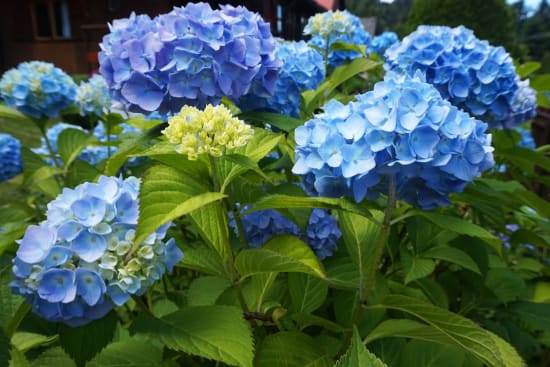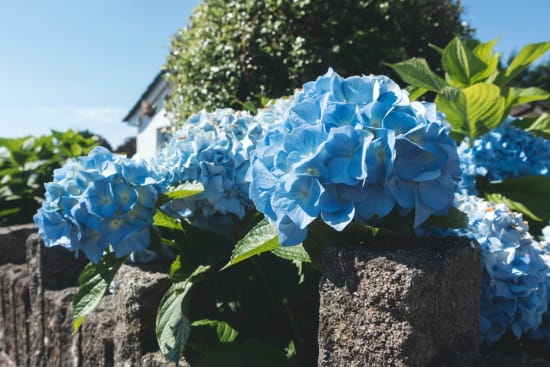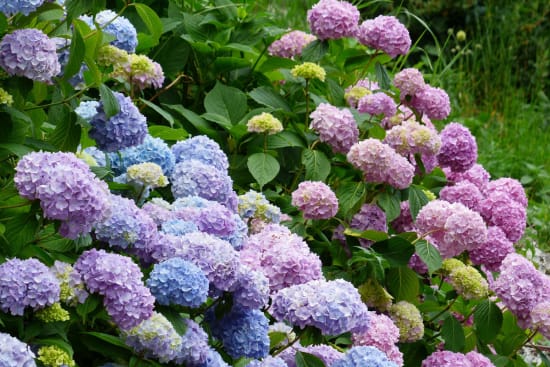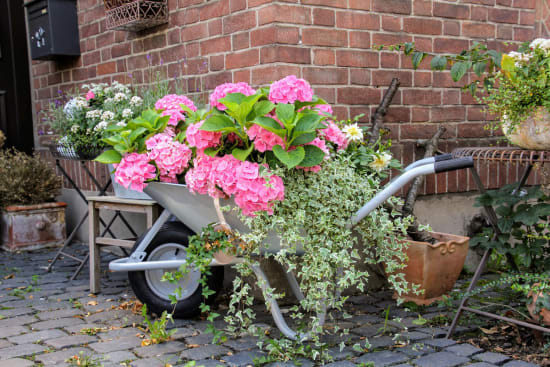Care tips - and all about blue hydrangeas
Here we give you simple care tips and reveal which hydrangeas turn blue and for what reason.

Abracadabra - hydrangeas that turn blue
Blue hydrangea does not exist by nature.
Only the composition of the soil causes flowers to turn blue.
But this is the case only with (most) pink Hydrangea
macrophylla and Hydrangea paniculata. Pure white or red
flowers cannot be changed. In addition, the color change takes
some time and is usually not complete until the second year.

Acidic soil and alum are prerequisites
For blue flowers, an acidic soil (pH value of between 4 and 4.5)
is important, as is the case with rhododendrons, for example.
Therefore, it is best to take special soil for rhododendrons or
water with «Hortensienblau», which makes the soil acidic.
For the blue color you also need alum (aluminum salt),
which is available in garden stores. To maintain the acidic
soil (especially when planted in containers),
you should use very soft water (e.g. rainwater) for watering.

Hydrangeas? They need a lot of water ...
Actually, almost any location is right for a hydrangea.
However, since it needs a lot of water, a wind-protected
spot in partial shade is best. Also ideal is a fresh,
well-drained and nutritious soil that is slightly acidic to neutral.
Speaking of water, provide sufficient moisture, especially in
dry and warm weather, but at the same time make sure that there
is no waterlogging. If the heat is persistent, hydrangeas
should be watered in the morning and evening, because they
evaporate a lot of water through their many large leaves.

Hydrangeas are not always hardy
In principle, hydrangeas are hardy. But to be on the safe side,
you can protect them from frost with some brushwood.
For potted plants, the container should have a diameter of at least 30-40 cm. Smaller containers should be wintered in a
frost-free, but cold place at about 3-5 degrees C.
More topics about hydrangeas and lavender
Hydrangeas offer everything you can wish for
Whether in terms of color and shape of flowers and leaves or height of the plant, with hydrangeas you have a choice. There are even climbing artists among them.
Care tips - and all about blue hydrangeas
Here we give you simple care tips and reveal which hydrangeas turn blue and for what reason.
Fancy a change? Hydrangea «Magical Four Seasons»
Fancy experiencing the change of seasons in hydrangeas too? «Magical» hydrangeas constantly change color.
Lavender - and you already feel like you're in Provence
Lavender is simply wonderful. In addition, there are many species and varieties, and the most diverse colors.
About symbolism and drying lavender
What message do you convey when you offer lavender as a gift? And how do you «preserve» lavender?
Lavender - ideal for hot summers
If you give lavender the right location, it is easy to care for and gives sunny gardens and balconies poetic vacation feeling.
Hydrangea and lavender are totally «retro»
Arrive and breathe a sigh of relief - surrounded by things you love. This explains not only the retro look, but also the popularity of hydrangeas and lavender.




